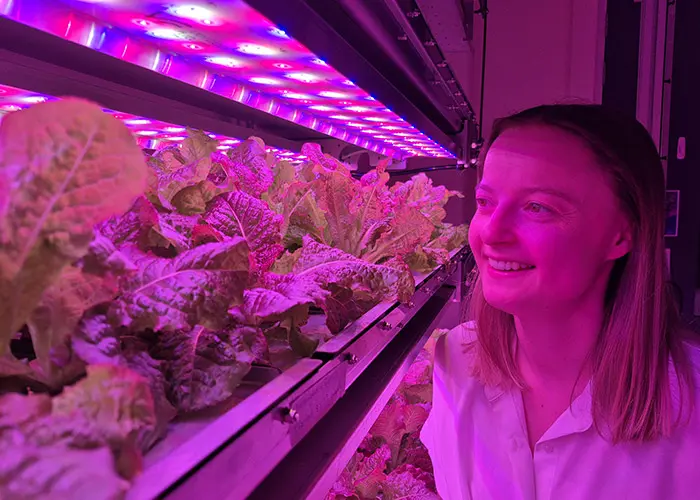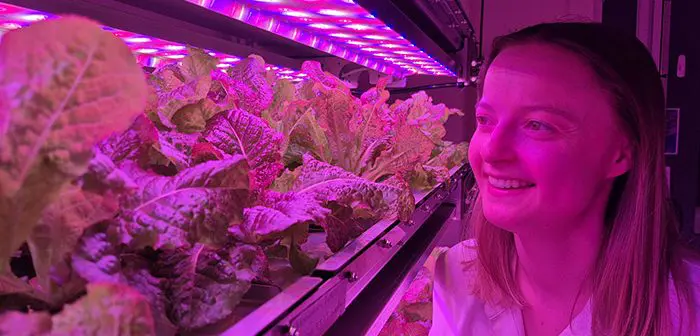
Extreme weather events, from heavy rainfall to heatwaves and droughts, are increasingly threatening crop yields globally, so new solutions are needed for agriculture.
An international team from the University of Adelaide, University of Cambridge, University of Western Australia and NASA have reimagined how we grow food into the future.
The paper has been published in the journal Trends in Plant Science and has been chosen for inclusion in an upcoming 30th anniversary special issue titled ‘Big concepts – shaping the future of plant science’.
“Controlled environment agriculture allows crops to be grown indoors under the precise control of light, temperature, humidity, carbon dioxide, and nutrients, while reducing pest risks,” says Dr Alison Gill (pictured), postdoctoral researcher at the ARC Centre of Excellence in Plants for Space, the University of Adelaide, and first author of the paper.
“The result is food that can be produced anywhere, year-round, with yields up to 20 times greater than traditional agriculture, with much less arable land and water required.
“By combining decades of plant science with new technologies to track crop health and fine-tune plant growth, we can grow food that is more consistent, nutritious and tailored to our needs. CEA is not a platform that will replace traditional farming, but it is a powerful supplement.”
While the work was inspired by research focused on growing plants in controlled environments in space as part of a UK and Australian Space Agency funded collaboration, the greatest impacts will be here on Earth.
“What began as space science, with experiments designed to grow food beyond Earth, has enabled us to create a blueprint to deliver big impacts back home. In Australia, container farms could bring fresh produce to remote outback communities, cut food miles, and help supplement farmers’ incomes during drought using recycled water,” says Dr Gill.
“We also envisage indoor plant-based pharmaceuticals and other high value bioproducts as a massive economic opportunity for CEA.”
To date, successful CEA production has been limited to small, pick-and-eat crops like lettuce, herbs, cucumbers, and microgreens, with considerable challenges in building and running the high-tech farms efficiently.
“We have identified specific targets that plant scientists must address, and the routes by which this could be achieved, as a pre-requisite for controlled environment agriculture to form a viable production platform going forward,” says Plants for Space Director and the paper’s senior author Professor Matthew Gilliham.
“This includes a pre-breeding pipeline for traditional horticulture, broadacre agriculture and even forestry, increasing opportunities beyond pick-and-eat crops.”
Head of Circadian Signal Transduction Group, Department of Plant Sciences, University of Cambridge, Professor Alex Webb said creative minds are needed to adapt crops to indoor environments, in combination with the latest technologies.
“It is only now that we have these tools, so by combining precise environmental control with cutting-edge plant science, we can begin to grow plants that are best suited to meet the challenges ahead,” he said.
“If implemented to its potential it would secure fresh food supplies locally all year round, even under extreme weather, from inner cities to the most remote corners of the planet and beyond.
“With the right investment, these innovations could redefine what it means to grow, eat, and share food in the 21st Century.”
The University of Adelaide and the University of South Australia are joining forces to become Australia’s new major university – Adelaide University. Building on the strengths, legacies and resources of two leading universities, Adelaide University will deliver globally relevant research at scale, innovative, industry-informed teaching and an outstanding student experience. Adelaide University will open its doors in January 2026.





